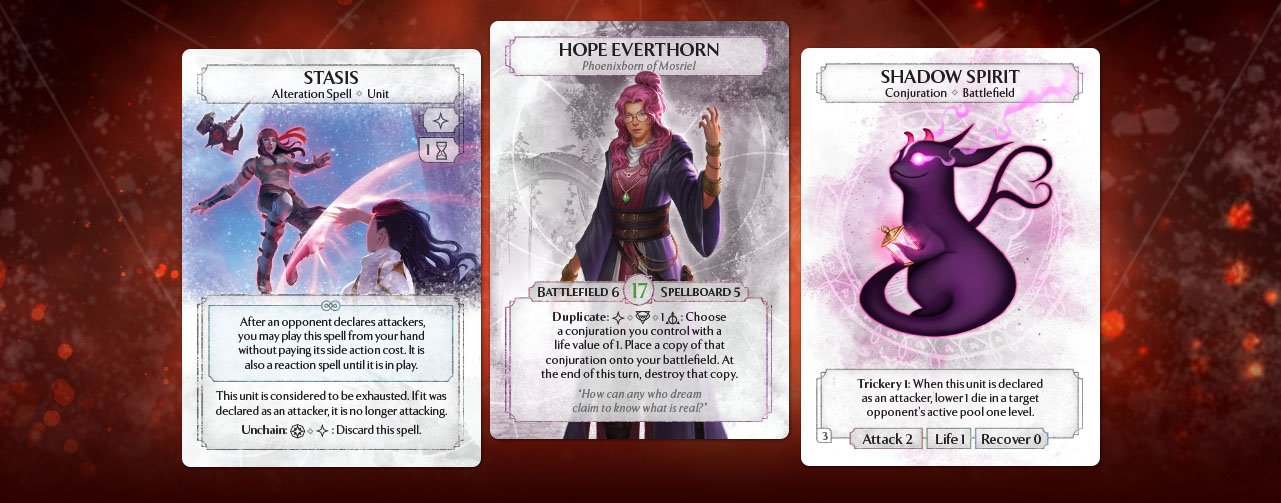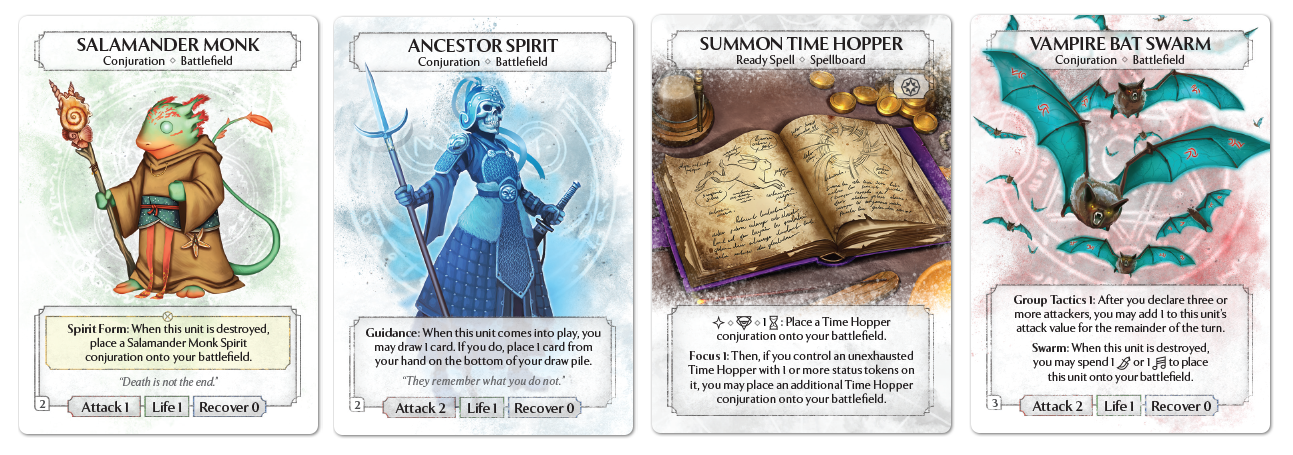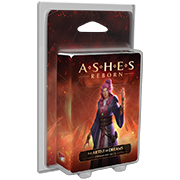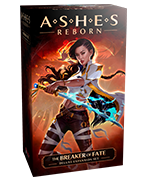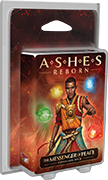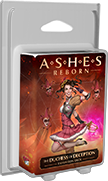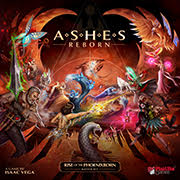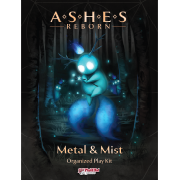Re-Constructed Deck - The Artist of Fables
Fables of Foxes and Feathers
Welcome back, Ashes players, to another installment of Re-Constructed. We’re going to take you on a little journey today, to the realm of imagination.
Hopefully, you’re already aware of the deck building restrictions we’re working with; if not, read the last Re-Con article (or any of the previous ones). For all the Time Phoenixborn, we’re also assuming you have The Breaker of Fates, as time dice will obviously be required to play them. Last week, we were highlighting a deck rather hungry for divine magic and their dice power, using Time more as a support. We’re doing something pretty similar this time with illusion magic, and are looking to push the aspect of its dice power to the fullest. You may need to meditate harder than usual against today’s deck.
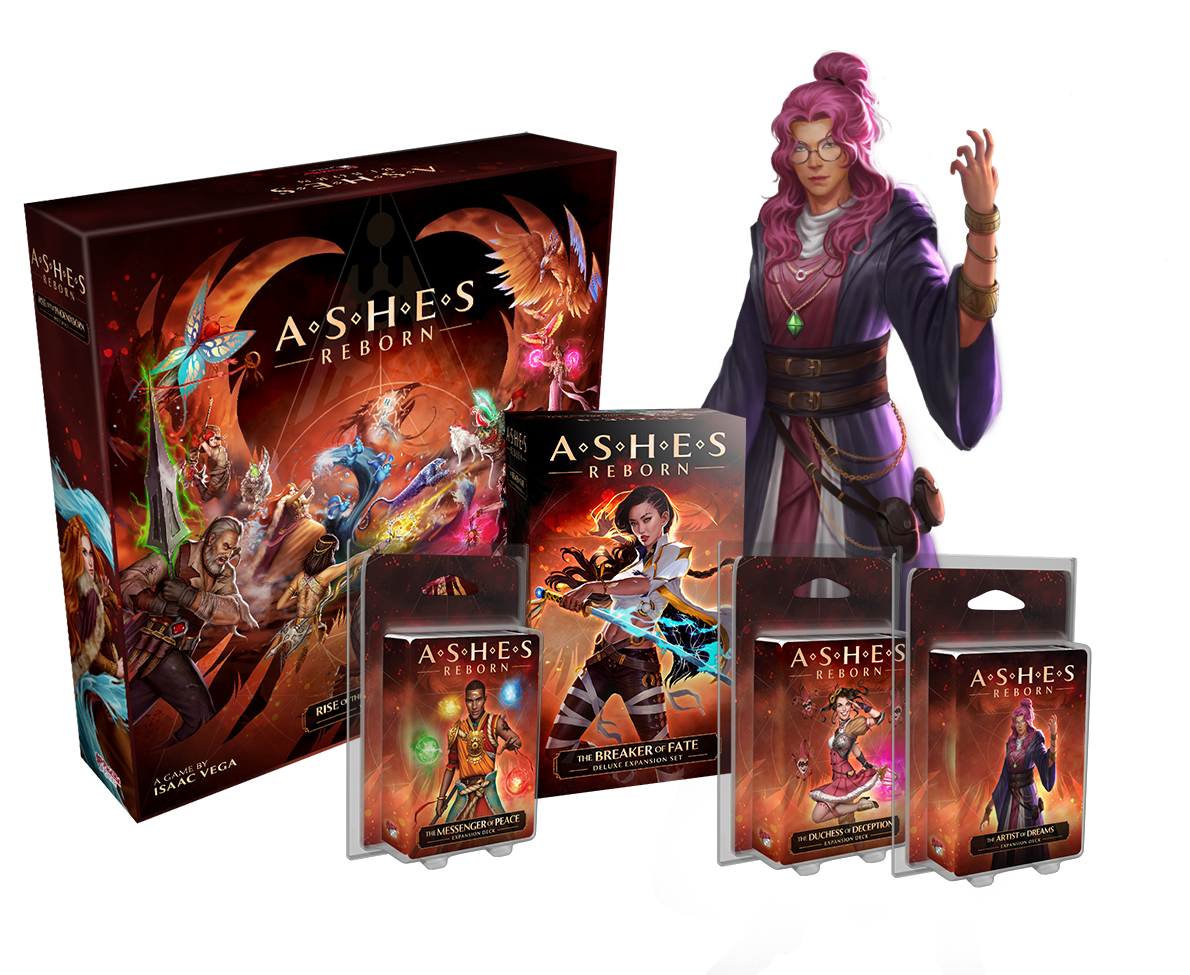
The Artist of Fables (Re-Hope)
6x Illusion, 4x Time
3x Summon Fox Spirit
2x Summon Shadow Spirit
1x Summon Wishing Wing
2x Dream Fracture
3x Keepsake
1x Reimagine
2x Dreamlock Mage
3x Realm Walker
1x Standard Bearer
1x Recollect
3x Stasis
3x Void Pulse
2x Double Down
2x Fate Reflection
1x Outmatch
Hope has a rather fascinating talent, the ability to manifest small illusions into being, like an illusionary summoner proper. While they're restricted to conjurations with a printed health of 1, this still opens them up to some surprisingly powerful plays. In the precon, Hope’s ability is meant to duplicate Fox Spirits to apply pressure (your opponent will need to think twice before exhausting any units) or Wishing Wings to draw more cards for late game power/setup. To maintain the lead even more aggressively, you have crazy reaction spells like Void Pulse and Double Down. When combined with Reimagine, this also opens additional opportunities for the illusion dice power to further hinder your opponent’s play patterns, or pump your own Wishing Wings. For having almost exclusively small units, Hope’s manifestations are surprisingly lethal. Rounding out the deck are further big bads: Realm Walker forces your units into early exhaustion to prop up the fox hunting, while both Dream Fracture and Dreamlock Mage apply a frankly stupefying amount of pressure on those poor helpless dice, further empowered with Keepsake. Even the act of guarding your vulnerable units comes under fire with Ensnare. Never before has your opponent felt so unsure about their own ability to play the game. Going into the re-con, the story is mostly the same, but we’ve added a couple plot twists.
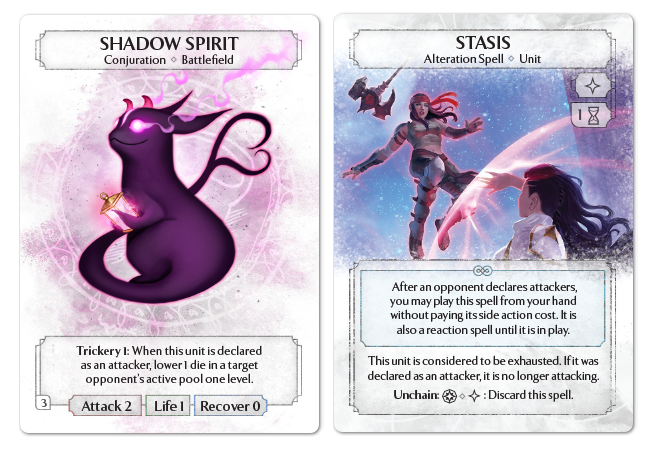
Dreamlock Mage and Dream Fracture are already providing some strong dice repression, but Shadow Spirit is going to help take it to the next level. It’s not enough that Shadow Spirit is a positive recipient for both Duplicate and Double Down, and synergizes well with Dreamlock Mage and Dream Fracture, but it also has the benefit of being the only conjuration in the deck with a base power of 2. A seemingly innocuous trait to be sure, but one that matters gravely. While Fox Spirits and Wishing Wings are great helpers, their roles in the story you’re weaving are a bit more particular; since their initial power never jumps above 1, it can be difficult to use them against larger threats. Shadow Spirit’s one additional power can make all the difference when aiming for a better outcome.
Another powerful addition comes with Stasis, a spell that’s easy to cast, stops our opponent’s attacks, and creates easy opportunities for our Fox Spirits to take the lead. While Ensnare has been cut out of the deck, Stasis should help cover some of the same bases by making our Fox swings more consistent and occasionally opening up a blocker for a larger scale swing. As for the rest of the deck, it remains largely untampered. With Shadow Spirit added, Wishing Wing is going to fall more into a support role for certain matchups rather than a mainstay conjuration, and we shouldn’t need so much Reimagine if we just tell the story right the first time around. Finally, we’ve also added a single copy of Recollect, which will be spicy in the late game as a way to get 2 additional copies of Keepsake. Dream big, as they say.
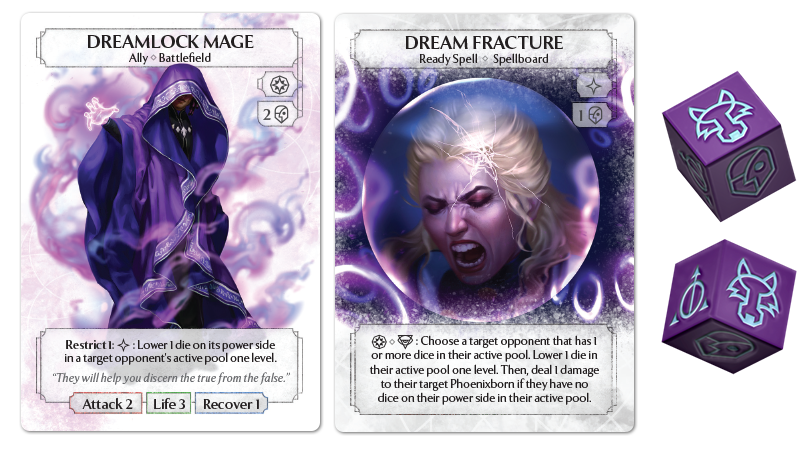
Now let’s get into strategy. It’s true that our lines are fairly straightforward. We do want to Duplicate units and attack with them, most often casting Double Down to accelerate our board and making a precision swing into Void Pulse. We also want to generally lower our opponent’s die faces to force more meditates and slowly advance a possible exhaustion victory. Even on just the surface level, our tactics are powerful because Duplicate is just that nuts of an ability, getting an entire extra unit’s worth of value for only 1 basic, and often forcing difficult trades via 2-attack shadows or 3-attack foxes, or even sneaking in card draw via birds. Generally speaking, if you aren’t Duplicating every single round, something is probably going wrong. Still, that’s all fairly boilerplate, to play this deck well will require a little more nuance.
Let’s start by breaking a few illusions. First, we’re not necessarily using Dream Fracture like it’s a Frost Bite. While there is burn attached to Dream Fracture that is very good, we’re mostly using it as a way to pressure dice without needing to overextend ourselves, and can be extremely powerful when paired with other sources of dice reduction. An illusion power combined with a Dream Fracture downgrades 3 dice in one round, making it incredibly difficult to keep power dice up. Your opponent may never summon a Turtle Guard ever again.
Second, we want to be more precise than simply lowering dice; the goal is to cut off potential opportunities, “crush their dreams” if you will. For this, you’ll have to actually pay attention to your opponent’s deck. Some decks are desperate for power dice (ours is a good example), in which case focusing on reducing their power symbols down to class is the best use of your resources. However, other decks get by just fine on class dice, in which case you’re better off focusing down as many class symbols to basic as possible even though it may leave them with occasional power symbols. Dice types can also factor into this: natural dice are your natural enemy, so keeping them down to class is essential (thanks Dreamlock Mage).
Finally, it’s okay to play defense. I know our units are primarily aggressive, but we’re not incapable of playing good defense, it just requires us to be a little more opportunistic. Our Wishing Wings and Shadow Spirits tend to trade well with attackers (Wishing Wing having an adjustable power via Time dice power helps). Fox Spirits are a little trickier; if they’re exhausted we probably have to let them go, but for the unexhausted ones we usually either want to Phoenixborn guard or play a Stasis, mainly to enable that fox to retaliate next turn with a 3 power swing. Your biggest defensive asset is Double Down, repopulating your board in that “Summon Sleeping Widows” fashion and enabling a dangerous counterattack. These are the natural strategies of most illusion magic decks: tricks and manipulation. The more you are able to force your opponent to play your game, the easier of a time you’ll have seeing the story to its natural conclusion.

First Five:
Your first five is going to play just a tiny bit slow before exploding all over the place. Three summon books and no allies may seem a little passive, especially with all these cheap units at the helm, but there’s a trick to it. Wishing Wing with an active Opportunist helps us draw cards, as does Duplicating said opportunistic bird. Combine this with Void Pulse and you’re likely drawing as many as 3 extra cards in the first round to help make up for our abundance of dice in round 1. Now, that’s all well and good in a perfect world, but a strong vision takes strong work and more than a little flexibility, so let’s talk flexing your first five.
We will probably always start with our two spirits, but the rest of the hand is pretty open. Against heavy natural or poke focused cards, consider bringing a Dreamlock Mage and Double Down, and if the opponent is Xander or Aradel also bring a Fate Reflection. Against bigger threats, you can threaten tougher board states with Realm Walker and Stasis, and even remove them handily with an early Keepsake or Outmatch. A combination of Double Down and Void Pulse may prove necessary against other low life aggro decks. If your opponent has a more passive strategy, a Standard Bearer can set you up very well for later turns by simply amassing additional attack power over time, while Dream Fracture burns them down. There’s a myriad of directions you can go with your first five, and it will take a bit of experience to find the best avenue for each opponent.
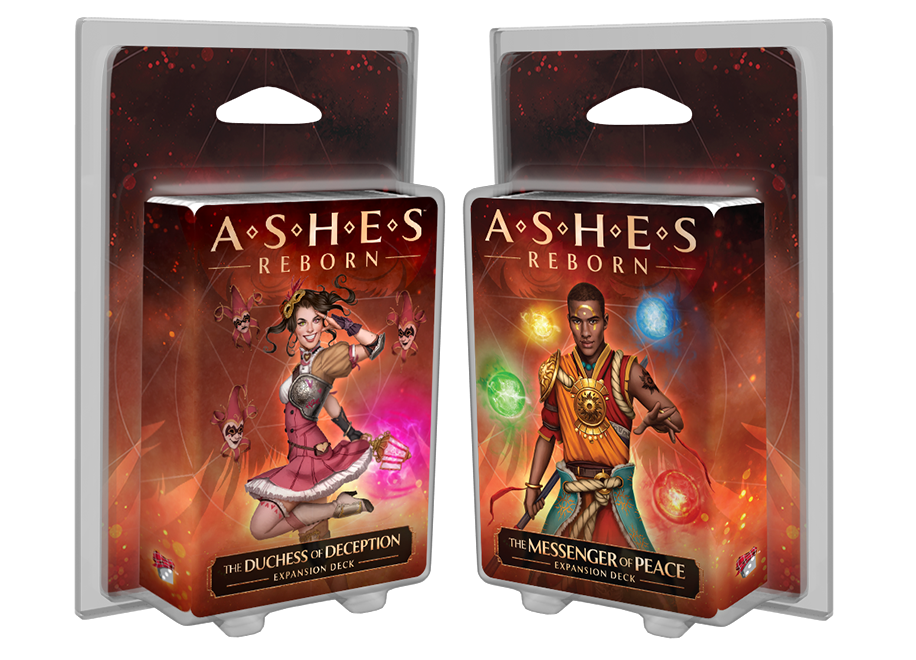
The World is Your Playground:
I can’t really imagine playing this deck without Shadow Spirit, it’s just such a strong unit in almost every scenario. Besides that, there’s other powerful options available in Victoria’s deck that we didn’t get around to, like Summon Shadow Hound (it’s a 1 life unit) and Figures in the Fog (though I think Stasis is still better for this deck). For those reasons, I think Victoria is pretty essential. However, we could make due without Orrick’s inclusions. Recollect is more of a fun card here than a strong one, and we could easily pivot out of Fate Reflection for the still powerful yet subtle Particle Shield.
Taking it further:
Regardless of how you build Hope, some part of their kit must revolve around Duplicate; the ability is too strong to ignore. Probably the best unit for taking advantage of this ability is Salamander Monk, since you’re always guaranteed a death trigger and a free unit every time, and both units in that pairing make for alright Double Down candidates. Ancestor Spirit can be pretty solid with its 2 power and extra deck filtering, while Time Hopper is pretty great with Wishing Wing, Mirror Spirit, or any other unit you want to gift some status towards. Among the more explicitly aggressive options are Vampire Bat Swarm and Sleeping Widows, though I think you can get most of the same benefits with Salamander Monk instead, if not the same level of pressure. Two of the weirder choices are Orchid Dove in a grind focused charm magic deck, or Indiglow Creeper which might do well paired with Time Hopper. In any given case, I think you’ll find yourself likely splashing into sympathy magic with this Phoenixborn often.
That’s all for this week. Surprisingly, we’re almost finished, so before it's over we’re gonna relax next week with some fun fly fishing.
Andrew DiLullo is an animator, a game designer, and luckily also a writer. Having first discovered Ashes at the tail end of the first round of expansions in 2016, he’s been playing ever since and currently heads the Bay Area Ashes group in California. He was especially active in several community projects after Ashes was canceled the first time, and now puts his attention to Reborn as the game starts anew. He’s currently designing a board game in his spare time, and occasionally writes on his online journal: The Lighthouse Library.


